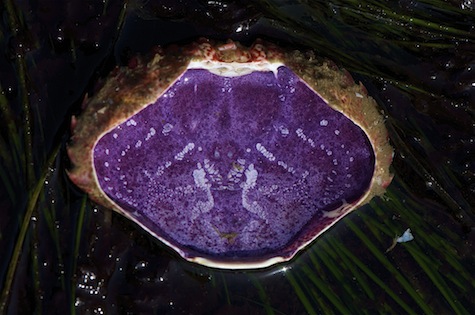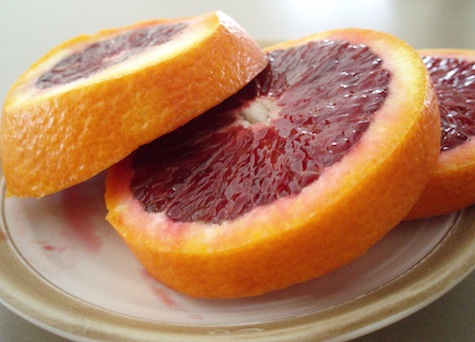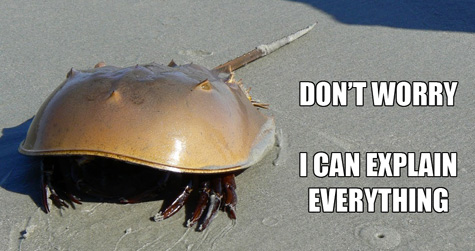When I first sat down to plan this article, I knew what I was doing. I was going to flesh out the theories I hinted at near the end of my Rosharan ecology article by discussing how well every lifeform on Roshar fits into a certain pattern, with the notable exception of humans. I would pepper it with some science, spin some theories about our conceptions of the Other in SFF, and call it a day. Then I started doing research, and a winding tunnel of possibilities opened up below me. I still plan to do all those things I said, but the path I take to explain is going to be… a lot stranger. And it is going to involve crab blood. Do you like crab blood? Do you want to know more about crab blood? Because that’s what I’m offering at this point: crab blood, with a bit of lobster fluids thrown into the mix.
Chapter One: Reasonable Premises
If you’ve read my previous article, you know how well adapted the plants and animals are to the regular battering forces of the Highstorms. Humans have shown none of the same tendencies towards biological adaptation. As far as I can tell, outside of occasional propensities for magic, the people of Roshar are normal, garden-variety humans, even in the absence of gardens. Instead of adapting to their surroundings, mankind has adapted their surroundings to them. Towns are built in the shelter of hills. The city of Kharbranth has an entire mountain at its back, with most of the royal complex and the Palanaeum library being carved straight down into the bowels of the mountain, Erebor style. Kholinar nestles amid wave-like rock formations. Most amazing of all, however, is Sesemalex Dar, capital of Emul. The city is built in giant troughs, keeping their homes below the ground, with lids at the top of the chasms to keep the city dry, and an incredible semi-natural drainage system at the bottom.
These cities are rumored to be Dawncities, created in times of legend by the mysterious Dawnsingers. These mythical creator figures must have applied monumental magical force or unbelievably skillful engineering to carve out a niche for humankind, whose soft, squishy bodies couldn’t possibly survive. There’s only one place on the planet where human survival without incredible magic or technology makes sense: Shinovar. Far to the west, separated from most of the continent by mountains, Shinovar is a haven of what we would consider normal. There is grass, which doesn’t even move. There are trees, and fields, and soil. They breed horses there. They keep chickens and pigs. In fact, ecologically, it seems almost exactly like European earth. They even grow strawberries.
This strikes me as massively out of place. This pocket of land that is almost like earth, where things run around being shaped like Earth animals without even a cursory fantasy reskinning, clashes terribly with the land of giant crabs and lobster-dogs and grass that runs away. How is a chicken supposed to survive a hurricane, anyway? Perhaps Shinovar is the cradle of life on Roshar, the evolutionary homeland of all humankind. They don’t fit the evolutionary pattern of the rest of the continent. But can an explanation of that other evolutionary pattern be put forward that covers some of the stranger details?
Chapter Two: The Descent
There’s something that’s been bothering me for a very long time, and I wanted to try to address it while researching this article. Why do chasmfiends have purple blood? Why does it smell like mold? What is going on here?! So, while formulating my theories that humans are either alien invaders to Roshar, brought over by the Heralds to subjugate the land and carve out an ecological niche from which to thrive, I decided to nail down some scientific arguments for how Rosharan ecology made sense, to prove that it was consistent without humanity. Sadly, any search for purple blood yields a collection of music videos, ebooks, and Yahoo Answers results, none of which were up to my Exacting Research Standards. After an amount of searching that made me start to question my life choices, I made a huge breakthrough.
From my Twitter:
WHOA! STOP THE PRESSES! Horseshoe crabs have blue blood! This changes exactly one specific thing! I’m onto you, @BrandSanderson.
—Carl (@EngleLaird) June 14, 2013
Sometimes you make discoveries that can change the course of your life forever. Sometimes they just reshape an entire afternoon. When I learned that horseshoe crabs have blue blood, I was hooked. I had to go further. (BEWARE: Horseshoe crab gore beyond this point.)

Instead of using hemoglobin, the oxygen-carrying protein in mammalian blood, horseshoe crabs rely on hemocyanin. These proteins contain two copper atoms that bind to oxygen, and when oxygenated become blue. Horseshoe crabs aren’t the only species that use hemocyanin, though, the proteins can also be found in many species of mollusks and crustaceans, including some lobsters and crabs. And look at that vivid purple color inside the crab. But hemocyanin isn’t enough on its own to make blood appear violet.
Chapter Three: Wild Speculation
Crustaceans just don’t grow as large as chasmfiends, ever. Sanderson has said that some of the factors that allow the massive size that greatshells reach is the high oxygen content of the air and the low gravity. So, does this mean greatshells need more oxygen to live? What if, to provide evolutionary redundancy, greatshells developed parallel oxygenation mechanisms? Blood that carries both hemoglobin and hemocyanin? Red proteins and blue proteins, coming together to make purple blood!
I am well beyond scientific proof at this point. I am speculating, and proud of it, because that’s what I love to do with Roshar. I love to pull back the layers and convince myself that the world is rich enough to support my crazy theories. And I think, in this case, at this point, I’m right that the world can support the weight of my guesses. But creating a personally satisfactory explanation for why greatshells have violet blood wasn’t enough for me, for one simple reason.
If I wanted to say that humans shouldn’t have evolved on Roshar, I had to prove that the Parshendi did. The other humanoid species on Roshar, the Parshendi, look very different from normal humans. They have red, black and white marbled skin and wear orangish armor that seems to be some kind of natural carapace. They can also jump much farther than humans, leaping across the chasms of the Shattered Plains. Some have speculated that the Parshendi communicate by song, or that they have some kind of weird hive mind. We know that they can travel outside during the highstorms, because they’ve burned down Alethi bridges while the storms were raging.
The Parshendi seem so much more natural a fit for this world. They’re more like crustaceans, with their partial exoskeletons, and they’re more physically adjusted to the harsh environment. But there’s a complicating factor. The Parshendi have orange blood.
Chapter Four: A Desperate Quest
You know I had to figure out how blood can be orange. You know what has orange blood in nature? Nothing. Nothing has orange blood. That made my job more difficult. In a weak moment, I admit it, I turned to Yahoo Answers, which told me that sometimes orangish blood can be a symptom of iron deficiencies. But really? An entire species with iron deficiencies? I was getting nothing. And it’s even harder to research orange blood than it is to research purple blood. Why, you ask?

Blood oranges. Defeated by delicious fruit. But I persevered. I dug deeper. I found a disgusting “bleeding” mushroom that made me not want to live on this planet anymore that supposedly sometimes has orange “blood,” but in every picture that “blood” was bright red. I drew wild conclusions and started wondering what would happen if a crab became anemic. It was a confusing time in my life, and one I still regret, but it has a happy ending.
Chapter Five: Victory, But At What Cost?
Eventually, I decided to ask a medically-inclined friend of mine who had also read The Way of Kings for help. She at first suggested rifampicin, a bactericidal antibiotic drug known for making various bodily fluids turn red-orange. Producing a bacteria as an antibacterial agent would be a pretty cool thing for a fantasy race to do, but it wasn’t exactly what I was looking for. Then, after a long back and forth, my excellent friend tossed me this sentence: “Look, maybe these guys just have hemolymph like insects do. Then their lymph fluid can be orange.”
Hemolymph! I had never even heard of hemolymph! And googling “orange hemolymph” was much less likely to result in delicious fruit! Sure enough, orange hemolymph yielded results almost immediately, and what I discovered was more perfect than I could have imagined.
Behold the glory that is this scientific paper from UMass Amherst: “Using Serum properties and shell-condition as an indicator of stage of maturation of the American lobster, Homarus americanus.” This article showed that lobsters can sometimes have orange hemolymph, usually indicating advanced ovary development. Maybe not enough to make an entire species have orange blood, but hey, I had my answer. The Parshendi are now officially lobstermen.
It starts to make more and more sense. The carapaces, the skin mottling, the, uh, jumping skills… Almost everything pointed to a lobster influence on Parshendi evolution. This links them to the chasmfiends, the axehounds, and so many more animals of Roshar.
So here I stand, at the end of this journey, unsure if I’ve uncovered the deepest, truest secrets of the creation of Brandon Sanderson’s world or spun out an insane yarn that will be universally ridiculed. And what have I taken away from it? A deeper understanding of all the crazy fluids that are essentially for the biological systems of many and varied species, a deep and abiding love of blood oranges, and a more complete self-understanding. Yes, I will go this far to try to make a theory work. And I think I have to be proud of that.
Carl Engle-Laird is the editorial assistant for Tor.com. He is one of the Way of Kings rereaders and Tor.com’s resident Stormlight Archive correspondent. He is better now, he promises. You can follow him on Twitter.










